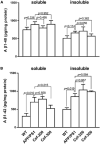Ceftriaxone Suppresses Group II Metabotropic Glutamate Receptor Expression Contributing to Reversal of Recognition Memory Deficits of Amyloid Precursor Protein/Presenilin 1 AD Mice
- PMID: 35860293
- PMCID: PMC9289516
- DOI: 10.3389/fnins.2022.905403
Ceftriaxone Suppresses Group II Metabotropic Glutamate Receptor Expression Contributing to Reversal of Recognition Memory Deficits of Amyloid Precursor Protein/Presenilin 1 AD Mice
Abstract
Group II metabotropic glutamate receptors (Group II mGluRs) are the peri-synaptic receptor of glutamatergic neurons and negatively regulate glutamate release from presynaptic neurons. Glutamate in the synaptic cleft is mainly taken into astrocytes by glutamate transporter-1 (GLT-1), which is primarily expressed in astrocytes. Increasing evidence showed that inhibiting or suppressing the activation of Group II mGluRs would contribute to the improvement of learning and memory deficits in Alzheimer's disease (AD) animal models. Ceftriaxone (Cef) has been reported to alleviate the spatial memory deficits in AD model mice by improving GLT-1-related clearance and metabolism of glutamate. Therefore, the present study further investigates the improving effect of Cef on recognition memory deficits and the involvement of Group II mGluRs in the process using the APP/PS1 AD mouse model. Novel object recognition tests showed that the Cef treatment significantly improved the recognition memory deficits of the AD mice. The Western blot and immunohistochemistry analysis showed that the Cef treatment significantly suppressed the upregulation of Group II mGluRs expression in APP/PS1 AD mice. The above suppression effect of Cef was blocked by dihydrokainic acid, an inhibitor of GLT-1 uptake activity. Furthermore, the Cef treatment significantly restored the downregulation in the downstream molecules of Group II mGluRs activation, including the expression of PKA and phosphorylated SNAP-25 in the APP/PS1 AD mice. The Cef treatment had no effect on the content of Aβ40 and Aβ42 in the hippocampus of APP/PS1 AD mice. The above results suggested that the suppression of Group II mGluRs contributed to the Cef-induced reversal of the recognition memory deficits in APP/PS1 AD mice.
Keywords: APP/PS1 mice; GLT-1; Group II mGluRs; SNAP-25; ceftriaxone.
Copyright © 2022 Fan, Li, Liu, Li, Xian and Li.
Conflict of interest statement
The authors declare that the research was conducted in the absence of any commercial or financial relationships that could be construed as a potential conflict of interest.
Figures





Similar articles
-
Ceftriaxone Improves Cognitive Function and Upregulates GLT-1-Related Glutamate-Glutamine Cycle in APP/PS1 Mice.J Alzheimers Dis. 2018;66(4):1731-1743. doi: 10.3233/JAD-180708. J Alzheimers Dis. 2018. PMID: 30452416
-
Ceftriaxone ameliorates hippocampal synapse loss by inhibiting microglial/macrophages activation in glial glutamate transporter-1 dependent manner in the APP/PS1 mouse model of Alzheimer's disease.Brain Res Bull. 2023 Aug;200:110683. doi: 10.1016/j.brainresbull.2023.110683. Epub 2023 Jun 8. Brain Res Bull. 2023. PMID: 37301482
-
Ceftriaxone regulates glutamate production and vesicular assembly in presynaptic terminals through GLT-1 in APP/PS1 mice.Neurobiol Learn Mem. 2021 Sep;183:107480. doi: 10.1016/j.nlm.2021.107480. Epub 2021 Jun 18. Neurobiol Learn Mem. 2021. PMID: 34153453
-
Ceftriaxone as a Novel Therapeutic Agent for Hyperglutamatergic States: Bridging the Gap Between Preclinical Results and Clinical Translation.Front Neurosci. 2022 Jul 5;16:841036. doi: 10.3389/fnins.2022.841036. eCollection 2022. Front Neurosci. 2022. PMID: 35864981 Free PMC article. Review.
-
The Implication of Glial Metabotropic Glutamate Receptors in Alzheimer's Disease.Curr Neuropharmacol. 2023;21(2):164-182. doi: 10.2174/1570159X20666211223140303. Curr Neuropharmacol. 2023. PMID: 34951388 Free PMC article. Review.
Cited by
-
Sulbactam protects neurons against double neurotoxicity of amyloid beta and glutamate load by upregulating glial glutamate transporter 1.Cell Death Discov. 2024 Feb 6;10(1):64. doi: 10.1038/s41420-024-01827-5. Cell Death Discov. 2024. PMID: 38320997 Free PMC article.
-
Harnessing electroacupuncture: a promising strategy against sleep deprivation-exacerbated post-cardiac arrest brain injury.Sci Rep. 2025 Aug 10;15(1):29277. doi: 10.1038/s41598-025-15563-y. Sci Rep. 2025. PMID: 40784914 Free PMC article.
References
-
- Ali I., Boets S., Janssens P., Van Eetveldt A., Amhaoul H., Langlois X., et al. (2016). Metabotropic glutamate receptor 2/3 density and its relation to the hippocampal neuropathology in a model of temporal lobe epilepsy in rats. Epilepsy Res. 127 55–59. 10.1016/j.eplepsyres.2016.08.010 - DOI - PubMed
-
- Anderson C. M., Swanson R. A. (2000). Astrocyte glutamate transport: review of properties, regulation, and physiological functions. Glia 32 1–14. - PubMed
LinkOut - more resources
Full Text Sources

